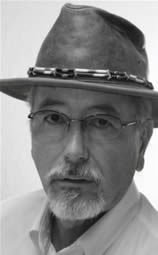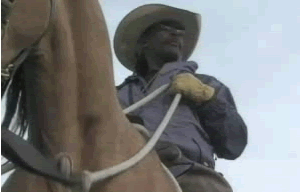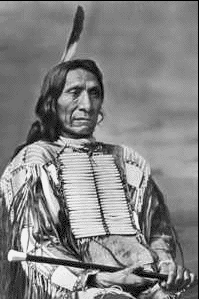Educator/Equestrian
|
New York To California Trail Rider |
Fee: Please contact for more Info |
Mr. Dean Commutes from New Jersey
|
|
|
For Archive Commentaries Click Here 
Arizona
My comments on the African experienced in America (Black Americans)were written from both a personal and intellectual perspective and so for this commentary on the Indigenous people, I felt it would be better served if it came from similar perspectives. Therefore, I have asked that James Riding-In, an associate professor of American Indian Studies at Arizona State and member of the Pawnee Nation of Oklahoma post the commentary on Who's land..Our Land (part II).
Who's Land...Our Land (part II)
It was a pleasure to have met Miles on March 9, 2008, in the Sonoran Desert on the Salt River Pima Maricopa Indian Community reservation in Arizona as he was making his epic cross-country ride to educate the nation about issues facing American Indians and African Americans. On that day, he sat tall and straight in the saddle as he rode Sankofa onto the site of a
powwow honoring American Indian veterans. He and this beautiful Arabian
stallion immediately attracted the attention of children who flocked around
the both of them. It was a beautiful sight to behold.
The entirety of Miles' trip took him through Indian country. Traveling on
horseback surely gave him the opportunity to ponder the beauty of the
landscape and how it must have changed since the destructive arrival of the
European colonizers. A stark reality of history is that most of the land he
traversed had long since been cleared of its Indigenous inhabitants who had
prospered by living in harmony with nature. Most Arizona Indians
fortunately escaped the trauma of forced removals if not the policy of using
coercion to turn Indians into mirror images of white Americans.
As the horrors of ethnic cleansing progressed, white settlers occupied
Indian country, often using slave labor to transform the land into a
commodity that could be bought, sold, and exploited. Although U.S.
occupancy of the land has had profound environmental consequences including polluted air, soil, and water; deforestation; social, political, and
economic inequality; and global warming, many of us descendants of the
Indigenous survivors continue to regard the appropriated lands as ours.
My Indian ancestors belonged to the land. They viewed Mother Earth as
possessing a sacredness deserving of respect. Their spirituality was rooted
in the concepts of place, ceremonialism, reciprocity, collectivism, and
living in harmony with nature. Today we are still clinging to these beliefs
despite the tragedies that have harmed and disempowered us.
Expressing to Miles an overview of this history became an important to me.
I had learned of his journey several days before his arrival in the Phoenix
area when my friend Professor Maceo Crenshaw Dailey, the director of the
African American Studies at the University of Texas, El Paso, emailed asking if I would be willing to meet with Miles and discuss American Indian history with him. Dr. Pat O¹Brien, an employee of the National Park Service, had also called me when Miles was in Pat¹s Tucson office, and I got a chance to speak with him for the first time. Maceo, Pat, myself, and others are working collaboratively to build the Warriors Project. This initiative has several interrelated goals. One of its aspirations is to study of the historical relationship between American Indians and those African Americans called Buffalo Soldiers who served in segregated military units during the U.S. government¹s campaign to overpower and dispossess Indians. Despite common notions saying that Indians were the aggressors, this is not the case. This mythology is central to a master narrative concocted to justify, rationalize, and dignify the history of white American expansionism. In their fighting and resistance my Indian ancestors were simply trying to defend their lands, ways of living, and human rights. Another aim is to encourage dialogue between American Indian and African American students regarding this often troubled and violent history.
During the time I spent with Miles, it became clear that we shared a deep
passion for historical truth and for protecting the rights of our respective
cultures. Today (April 4) is a very special day because it is the
anniversary of Dr. Martin Luther King Jr.¹s assassination at the hands of
what was very likely a conspiracy carried out by powerful people who wanted to silence the voice of this brave individual who led a non-violent protest against legalized racial segregation, economic injustice, political
oppression, the Vietnam war, and social problems plaguing this country¹s
past, present, and future. Although Dr. King¹s dream of a colorblind
society where a person ³will not be judged by the color of their skin but by
the content of their character² has advanced dialogue, if not systemic
change, concerning the issues civil rights and equality, this discussion
does not include Indian concerns. In fact, the goals of American Indian
nations differ in key respects from those of the civil rights movement. As
in the past, we Indians we are seeking to defend our sovereignty and lands
while maintaining a degree of measured separation from dominant society.
In this respect, it must be acknowledged that those Buffalo Soldiers who
distinguished themselves in battle did so by fighting on the side of
colonialism. A distinguishing feature of colonialism is its criminality.
It involves the taking of lands and life-sustaining resources through acts
of intimidation, aggression, and violence. This means that the U.S.
invasion disrupted virtually every aspect of Indian, altering our futures by
bringing premature deaths through warfare and starvation, dispossession,
poverty, forced removals from sacred homelands, coercive assimilation, and
oppression.
Enlisted men in uniform, especially non-whites, have no say in the formation and implementation of national policies. During the nineteenth century, the colonizers relied on their courts, executive office, legislature, and military power to subject Indian nations under what Lumbee legal scholar Robert Williams calls a ³white racial dictatorship.² The discourse used to justify atrocities, subjugation, and the taking of Indian lands and
resources essentially denigrated Indians as bloodthirsty ³savages² who
preyed relentlessly on innocent white children, women, and men. The ³s²
word for Indians is equivalent to the ³n² word for African Americans.
The U.S. Supreme Court has and continues to this racial language of the
Indian as a savage to rationalize the crimes perpetrated against Indian
peoples and to erode Indian sovereignty. It has held that Indians lost
title to their land by virtue of the Europeans¹ ³discovery² of the Americas.
This judicial body used negative stereotypes and assertions of European
superiority to proclaim that Indian nations were political subservient to
and wards of the U.S. government. It has also declared that Congress has
plenary, or absolute, power over Indian nations.
After taking away our ability to resist and to confine us on reservations,
federal policymakers refused to acknowledge that we had a right to govern
ourselves, to worship freely, and to exist without interference.
Fortunately, during the twentieth century, federal policy became less brutal
and oppressive. It now recognizes the rights of Indian to self-government
but under the auspices of paternalistic federal authority.
Our struggles as the First Peoples of this land include the ability to
defend our birthright to live as indigenous peoples with inherent political,
economic, and social rights. We are still fighting for such fundamental
rights as religious freedom, the right to rebury our dead that were stripped
from the womb of Mother Earth in the name of science and placed in museums, to determine our own futures, and to improve the quality of the lives of our peoples through the principle of self-rule. In this age of global warming, we Indians have much to teach non-Indians about living in harmony with nature.
This country has a long ways to go before it comes to grips with its
turbulent past. Miles¹ journey is a step towards this end. African
Americans, American Indians, and concerned other Americans must work
cooperatively for justice and dignity without forgetting that the issues
facing Indians differ dramatically from those others. For us Indians, the
ringing of freedom means the full restoration of our Indigenous rights. Let
the bells ring loudly everywhere very soon.
|
|